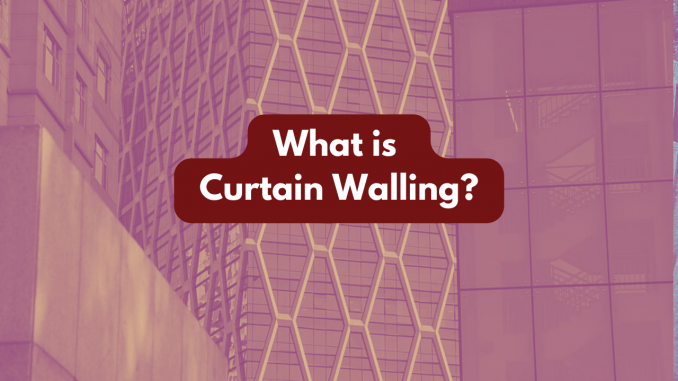
In the realm of modern architecture, the term “curtain walling” might sound intriguing yet elusive to many. However, this architectural marvel plays a pivotal role in shaping the aesthetics, sustainability, and functionality of contemporary buildings. In this blog post, we will delve into the concept of curtain walling, its benefits, and its significance in the world of architecture and design.
What is Curtain Walling?
Curtain walling refers to the non-structural, exterior façade or wall system that is designed to provide a building with a visually striking appearance while simultaneously offering protection against the elements. It consists of a series of glass panels, metal framing, and sometimes other materials such as stone or composite panels. These elements are assembled to form a cohesive unit that covers the exterior of a building, effectively creating a “curtain” of materials that separates the interior from the exterior environment.
Unlike traditional load-bearing walls, curtain walling doesn’t carry the weight of the building itself; rather, it hangs from the structural frame, giving the illusion that the building is enveloped in a lightweight, almost ethereal enclosure. This design approach allows for larger expanses of glass and offers architects the freedom to explore innovative and captivating designs.
The benefits of Curtain Walling
- Aesthetic Appeal: One of the most remarkable aspects of curtain walling is its ability to transform the visual identity of a building. The extensive use of glass panels creates a sleek and modern appearance, allowing natural light to flood the interior spaces and establishing a strong connection between the indoors and outdoors.
- Daylight and Energy Efficiency: The large glass panels in curtain walling enable a generous intake of natural light, reducing the need for artificial lighting during the daytime. This not only creates a more pleasant environment for occupants but also contributes to energy savings by reducing electricity consumption.
- Thermal Insulation: While glass is often associated with poor insulation, advanced curtain walling systems incorporate thermal breaks and insulating materials to enhance the energy efficiency of buildings. This helps maintain a comfortable indoor temperature while minimizing heat transfer through the façade.
- Weather Protection: Curtain walling acts as a barrier against the elements, protecting the interior of the building from rain, wind, and other environmental factors. The integration of weather-resistant seals and design features helps maintain a dry and comfortable interior.
- Flexibility in Design: Architects have the creative freedom to experiment with various configurations, shapes, and materials when designing curtain walling systems. This adaptability enables buildings to stand out as unique architectural statements while still adhering to functional requirements.
- Structural Efficiency: By relieving the building of the weight-bearing responsibility, curtain walling allows for more efficient distribution of loads throughout the structure. This, in turn, can lead to greater architectural innovation and flexibility in interior layout.
How do you know if a building has curtain walling?
Curtain walling has become a symbol of contemporary architectural design. Its ability to seamlessly merge aesthetics and functionality has revolutionized the way buildings are conceived. From towering skyscrapers to cutting-edge corporate offices and sleek residential complexes, curtain walling has left an indelible mark on the urban landscape, reshaping the skyline of cities across the world.
In conclusion, curtain walling represents a marriage of form and function that defines modern architecture. Its ability to captivate the eye while providing essential protection and energy efficiency underscores its significance in today’s construction industry. As architects continue to push the boundaries of design, it’s certain that curtain walling will remain an integral element in shaping the buildings of the future.
5 Examples of Curtain Walling
Here are some notable examples of buildings that incorporate curtain walling in their design:





- One World Trade Center, New York City, USA: Also known as Freedom Tower, this iconic skyscraper features a curtain wall façade made of glass and aluminium. The curtain walling not only offers a stunning visual appearance but also contributes to the building’s energy efficiency through its advanced insulation and solar shading systems.
- The Shard, London, UK: Renowned for its distinctive pyramidal shape, The Shard boasts an impressive curtain walling system that encompasses the entire building. Its glass façade provides panoramic views of the city while maintaining thermal comfort and weather protection.
- Petronas Towers, Kuala Lumpur, Malaysia: These twin towers are famous for their sleek design and innovative use of curtain walling. The curtain wall façade comprises reflective glass and stainless steel spandrels, creating a shimmering effect that changes with the lighting conditions.
- Burj Khalifa, Dubai, UAE: The world’s tallest building showcases an intricate curtain walling system that minimizes solar heat gain while allowing ample daylight to penetrate the interior spaces. The use of reflective glass and aluminium fins contributes to the building’s energy efficiency.
- The Louvre Pyramid, Paris, France: Designed by architect I.M. Pei, the glass pyramid entrance of the Louvre Museum is a masterpiece of minimalist design and creative curtain walling. The transparent glass panels contrast with the historic architecture of the museum, symbolizing a harmonious blend of old and new.


Leave a Reply